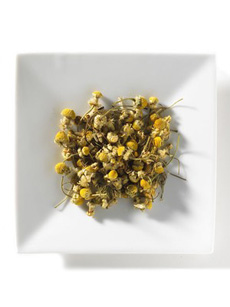
March 2005
Last Updated January 2026
|
 |
Best Tea, Types Of Tea & Tea Terminology
Tea Glossary Page 3: Terms With C
This is Page 3 of a 15-page glossary. Click on the links below to visit other pages. This Tea Glossary is one of our many food glossaries—find your favorite foods!
Click on a letter to go to the appropriate glossary page:
a b c d e f g h i j k l m n o p q r s t u v w x y z
This glossary is protected by copyright and cannot be reproduced in whole or in part. You are welcome to link to it.
CACHAR
The most common variety of Indian tea, from the Cachar district of Assam.
CADDY or TEA CADDY
The term for a tin or jar of tea, which takes its name from the Chinese or Malayan word “catty,” a term used to describe the weight of one pound of tea. In the past, tea caddies were equipped with a lock and key. Today, the name is used to describe ceramic dishes that hold the used tea bag before it is disposed of.
CAFFEINE
A stimulating compound present in tea. Black tea has the highest amount of caffeine, with diminishing amounts found in oolong, green, and white teas, respectively. Black tea contains about 40 mg per cup, depending on strength and steeping time; green tea has approximately 20 mg per cup. Coffee, by comparison, has 80 to 100 mg per cup.
|
|
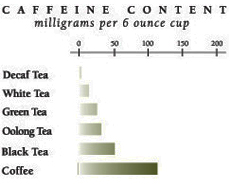 Chart courtesy Republic Of Tea. Chart courtesy Republic Of Tea. |
CAMBRIC TEA
A very weak tea infusion with a high percentage of milk and sugar, often given to children and invalids.
CAMELLIA ASSAMICA
There are two types of tea plants from which all tea derives. The names of these plants reflect their origins: Camellia sinensis (or chinensis, meaning Chinese in origin) and Camellia assamica, meaning Assam in origin, or indigenous to the Assam area of India. Assamica is an offshoot of Sinensis, transported to India, where the extremely hot climate (temperatures to 114°F compared to the cool mountain mists of China and Japan) caused the shrub to evolve into a tree that grows up to 30 to 40 feet high unpruned. However, it is kept pruned at three feet to five feet for convenient plucking of the tender leaves.
|
|
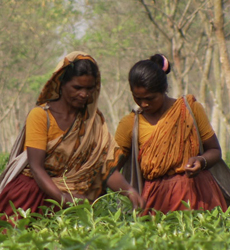
Plucking Camellia assamica tea in India. Photo courtesy Tetulia Tea. |
CAMELLIA SINENSIS
The botanical name for the tea plant. An evergreen shrub, C. sinensis is a member of the same family as the camellia flower, and has fragrant white flowers. Of the thousands of species of camellia, only C. sinensis produces an edible product. The tea was originally consumed as a medicine by chewing the dried leaves. Camellia sinensis has two principal varieties: Chinese tea, which has a small, olive-green leaf; and Assam (India) tea, Camellia assamica, which has a broad leaf and pale, fleshy shoots.
|
|
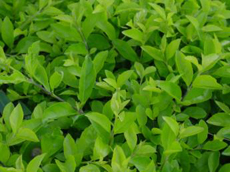 Camellia sinensis up close. Photo by Sandy Ardiansyah | SXC. Camellia sinensis up close. Photo by Sandy Ardiansyah | SXC.
|
The young plants spend their first year in nurseries before being planted out in the tea garden. The plant still needs to mature, and the leaves cannot be plucked for another 4 years. During this period, the plants are pruned regularly to keep them at harvesting height. They start to produce tea at the beginning of the fifth year. In general, a cultivated tea plant lives 40 to 50 years, although some varieties live up to 100 years. The plant grows in hot and humid climates with regular rainfall. The main tea-growing areas are:
- Africa: Cameroon, Kenya (10.25%), Malawi (1.56%), Mauritius, Mozambique,
Reunion, Rwanda, Zimbabwe
- Asia: Bangladesh, China (25%), India (25.63%), Indonesia (5.31%), Japan,
Malaysia, Nepal, Sikkim, Sri Lanka (9.65%), Taiwan, Vietnam
- South America: Argentina, Brazil, Peru
- Europe/Middle East: Georgia, Iran, Turkey (6.42%)
World production of tea in 2004 was 3,200,000 tons (source: U.N. Food & Agriculture Organization).

Camellia sinensis can be drunk as pure green or black tea (first and third from left), blended with blossoms, or finished in hundreds of different ways. Note: The red tea second from right, rooibos, is an herbal tea—known as a tisane, not true tea or Camellia sinensis. Photo courtesy of TeaForte.com.
CARAVAN TEA or RUSSIAN CARAVAN TEA
Caravan is a blend of two black teas: Chinese lapsang souchong and Indian Assam. The blend was developed in 19th-century imperial Russia; during the reign of the czars, Caravan tea was the most important drink in Russia after vodka in Russia. The lapsang souchong leaves are dried in bamboo baskets over pine fires to create a strong tea that has a smoky aroma. The addition of Assam provides a hint of malt flavor. It’s a great after-dinner tea. The name comes from the camel caravans that brought the tea overland from China to Moscow, using portions of the famed Silk Road (a 16-month round trip!). Caravan tea is often served heavily sweetened; honey or preserves are a better pairing than sugar.
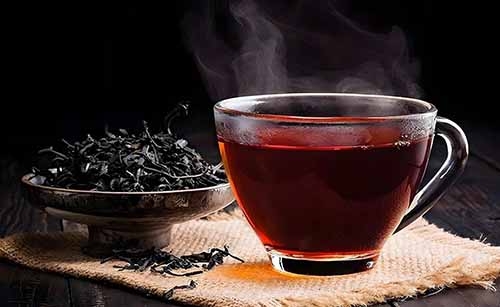
Russian caravan tea (photo © Tea Runners).
CATECHINS
A class of polyphenols present in high concentrations in green tea, but also found in varying levels in other teas.
CEYLON TEA
Ceylon is the colonial name for the island of Sri Lanka, which gives its name to blends of black teas grown on the island. The country converted to its original name in 1972 when it became a Sovereign Republic in the Commonwealth of England. The black tea from the mountainous interior of the country has a smooth flavor, a medium body, and a slightly fruity-honey finish. It is a favorite among black tea drinkers as a breakfast or afternoon tea.
|
|
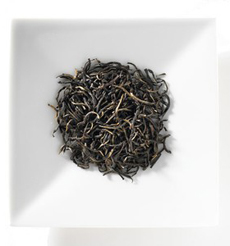
This Ceylon tea (photo © MightyLeafTea.com). |
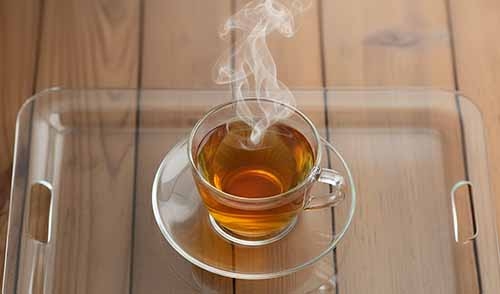
A cup of Ceylon tea (Abacus Photo).
CHA
The Cantonese, Mandarin, and Japanese word for tea. Other Chinese dialects have other words; e.g., the Wu dialect spoken around Shanghai uses the word zu, and the Hokkien dialect spoken around the port of Xiamen in the Fujian province uses the word tay. Read more about how the word “cha” traveled to the Middle East and Eastern countries, while “tay” traveled to Europe.
CHAI LATTE
A chai latte is a creamy, spiced tea drink made from black tea infused with aromatic spices (like cinnamon, cardamom, ginger, cloves). It weds chai masala, Indian spiced tea, with the steamed milk of an Italian latte. It’s often sweetened and topped with foam. This Westernized version of masala chai has the same spice base but with more milk and froth.
Dirty chai latte adds a shot of espresso to the spiced tea, creating a more caffeinated and complex drink, often served hot or iced with steamed milk. “Dirty” refers to the muddled color and taste of the espresso. The origin story credits a British barista in the 1990s who accidentally added a shot of espresso to a customer’s chai latte. It became a coffee shop staple in the UK, with Starbucks later popularizing it in the U.S.
Double the espresso shot, and you have a Filthy Chai Latte. Make it with non-dairy milk, and you have a Dirty Hippie Chai Latte.
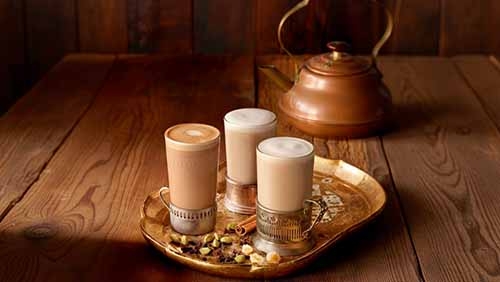
Chai latte (photo © Peet’s Coffee | Facebook).
CHAI TEA
A strong black Indian tea infused with milk, sugar, and spices—commonly cardamom, cinnamon, ginger, peppercorn, clove, and nutmeg (chocolate or licorice also can be used). In India, the beverage is known as masala chai, or spiced tea: Masala is the Hindi word for spice, and chai is the Hindi word for tea. While chai is traditionally made from black tea, green tea chai and rooibos chai have become popular.
|
|
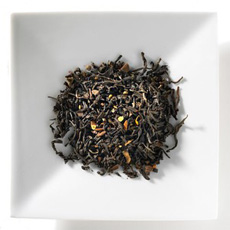
This chai tea is available at MightyLeafTea.com.
|
CHAMOMILE TEA
One of the most popular herbal teas, chamomile is made from the flowers of a plant that is a member of the sunflower family. It has long been used in folk medicine as a remedy for stomach aches, irritable bowel syndrome, and as a sleep aid.
The tea, brewed from the heads of the dried flower, has a golden color and a floral scent reminiscent of apples. It has distinct notes of apple and honey, and earthy or grassy undertones, similar to hay. It has long been used as a gentle, soothing, and calming beverage for relaxation or sleep. Like most herbal teas, it is caffeine-free.
The Egyptians revered chamomile for its perceived ability to cure ague, a febrile condition associated with malaria.
|
|
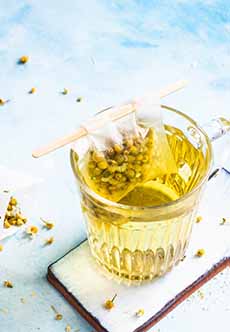
Chamomile tea. You can see the small flower heads hanging in the teabag. (photo © Monika-Grabkowska | Unsplash).
|
CHANOYU or CHA NO YU
Literally, “hot water for tea,” the Japanese tea ceremony. The tea ceremony was introduced into Japan from China in the 15th century by Buddhist monks as a semi-religious social custom. A highly formalized tradition, the simple act of making and serving a cup of tea is carried out through an elaborate set of procedures. Every movement is prescribed and requires great skill and poise. It takes years of study and dedication to be a true tea master. Traditionally, guests at a tea ceremony take off their shoes and enter a special tea room, where they sit on a mat on the floor, to receive tea and engage in light conversation. Frothy tea is made from powdered matcha with a bamboo whisk called the chasen (see photo). A sweetmeat, such as a sweetened rice cracker, may also be served.
|
|
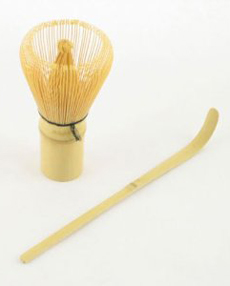
You can whip up the perfect cup of lump-free matcha for your tea ceremony, using a chasen (whisk) and a chashaku (scoop), both made of bamboo. You can purchase the pair at Amazon.com, as well as a complete Japanese tea ceremony set. |
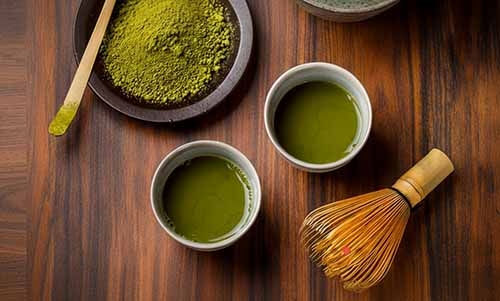
In the tea ceremony, matcha is whisked into boiling water (photo © Palais Des Thes).
CHARACTER
An attractive taste, generally referring to qualities specific to the particular tea.
CHEST
Bulk tea was originally shipped in trunk-like chests, made of wood and lined with aluminum or other metal foil (the early chests were lined with lead). Today, the term refers to a wooden display box with sections for different types of tea bags. The box is an elegant way to enable a tea-loving family or guests to choose they’re preferred type of tea. However, unless the bags are wrapped and sealed with foil—like the Bigelow tea bags at right—the handsome chests are not a good solution: The flavors of the different teas migrate within the chest and infuse each other, impacting their pure flavors. For example, Ceylon can end up tasting like weak Earl Grey.
|
|
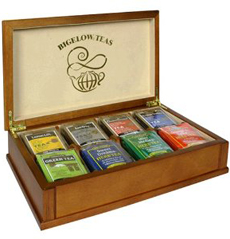
Bigelow tea chest available at Amazon.com. |
CHESTY
Tea tainted with the wood or metallic flavor of the shipping chest, due to inferior or unseasoned packing materials.
CHINESE TEA
A general reference to tea grown and processed in China, as opposed to tea from other main growing regions such as India, Japan, and Sri Lanka (Ceylon). While all tea comes from the Camellia sinensis plant, there are many different varieties of tea—estimates are between 700 and 1,000—based on different strains of the plant, local growing conditions, and differences in processing after the tea is harvested. Most of the tea grown in China is consumed in China, whereas India, Japan and Sri Lanka export a larger percentage of the tea grown there.
|
|
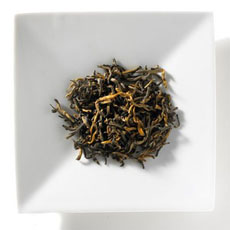
Yunnan tea, a black tea grown in the Yunnan province of southwest China, known for its spicy/peppery character. Photo courtesy MightyLeaf.com. |
CHONG CHA
Literally “worm tea,” this brew is made from the seeds of tea shrubs instead of the leaves. It is used in Chinese medicine for coping with the summer heat as well as for treating influenza.
CHOP
A mark placed on a break of tea (a lot of 18 chests or more). From the Hindi “chapna” meaning to stamp a number, mark or brand.
CHUNMEE or CHUN MEE
A green Chinese tea, the name means “precious eyebrow” in Mandarin. That’s because the curled, loosely rolled leaves are said to resemble a woman’s eyebrows. The leaf has a dusty appearance and brews a slightly darker liquor than many green teas. The brew has notes of dry plum and hints of smoke. Chun Mee was originally produced only in the Chinese province of Jiangxi, but is now also grown elsewhere. It’s not the easiest to find, but you can find it here.
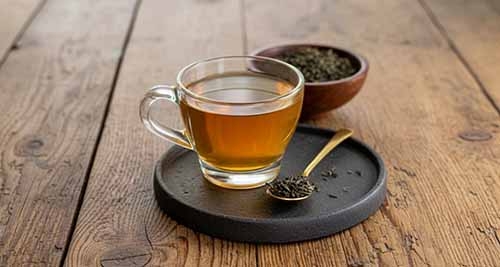
Chunmee tea (photo © The Jasmine Pearl).
CLONING
Cuttings taken from old tea bushes to produce new tea bushes. Today, most tea bushes are grown from clones or from cuttings taken from older bushes.
COARSE
A tea producing a harsh, undesirable liquor with a taste to match.
COLD INFUSION
Instead of brewing tea in boiled water, you can do it in cold water, a process known as cold infusion. Instead of the conventional steeping in very hot water for three to five minutes, cold infusion steeps the tea in cold water over several hours. It draws out the natural sweetness in the leaf, and since it’s so gentle, it’s hard to overbrew and develop bitterness. To make a pitcher, add a generous two teaspoons of tea to 8 cups of cold water; refrigerate for four or five hours. Strain and serve.
COMPLEX
The harmonious melange of different flavors, which is characteristic of the very finest teas.
CONGOU
A general term used to describe all black China teas regardless of the region in which they are grown. Derived from the Chinese word gongfu.
CONSTANT COMMENT TEA
Ruth and David Bigelow decided to switch careers to the tea and spice business, and in 1946, Ruth developed a blend in her tiny New York City kitchen, based on a recipe popular in the South in colonial America. The recipe called for black tea to be blended with orange peel and sweet spice. Ruth gave some to a friend, who served it to guests. “Ruth, your tea caused nothing but constant comment,” the friend reported,” giving Mrs. Bigelow a name for her creation, which soon appeared on the shelves of Bloomingdale’s; the story appeared in the New York Herald Tribune. Read the story of the Bigelow tea empire in the book My Mother Loved Tea. Make this recipe for Constant Comment Spice Cake—served with a cup of Constant Comment tea, of course!
|
|
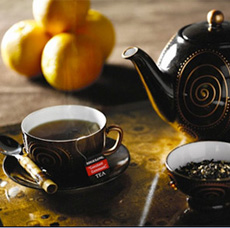
Constant Comment tea, flavored with orange peel and sweet spices, became so popular, it spawned not only a decaf version but a Constant Comment green tea (both photos © Bigelow Tea. |
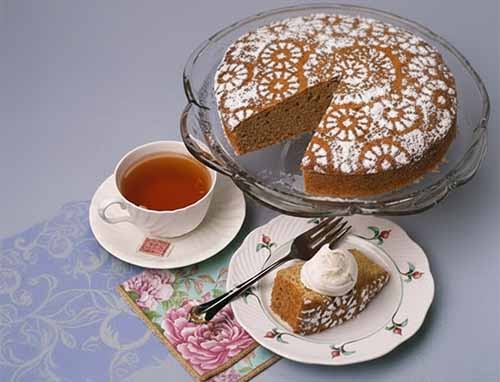
Here’s the recipe for this spice cake, perfect with Constant Comment.
CHOPPERY
A bright infusion indicating good quality black tea.
COUNTRY GREENS
A term originally used to describe China’s green teas, excluding those coming from the towns of Hoochow and Pingsuey.
CTC
An acronym for crush, tear, and curl, a machine-based process that macerates the leaves by pressing them through counter-rotating rollers to create a stronger, more highly colored tea.
Continue To Page 4: Tea Terms Beginning With D & E
Go To The Alphabet Index Above
Lifestyle Direct, Inc. All rights reserved. Images are the copyright of their respective owners.

|


